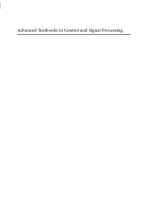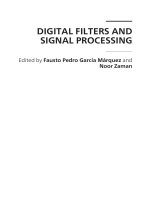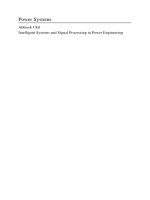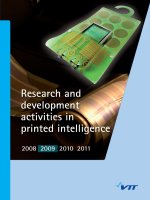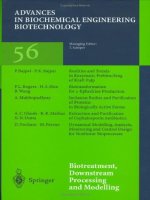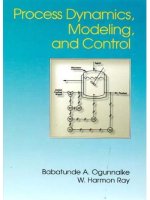Intelligent Systems and Signal Processing in Power Engineering ppt
Bạn đang xem bản rút gọn của tài liệu. Xem và tải ngay bản đầy đủ của tài liệu tại đây (10.88 MB, 383 trang )
Power Systems
Abhisek Ukil
Intelligent Systems and Signal Processing in Power Engineering
Abhisek Ukil
Author
Intelligent Systems
and Signal Processing
in Power Engineering
With 239 Figures and 36 Tables
Author
Dr. Abhisek Ukil
ABB Corporate Research
Segelhofstrasse 1K
CH-5405 Baden-Daetwill
Switzerland
ISSN 1612-1287
ISBN 978-3-540-73169-6 Springer Berlin Heidelberg New York
Library of Congress Control Number: 2007929722
Matlab
is a registered trademark of Mathworks Inc.
In short, no guaraentees, whatsoever, are given for the example computer programs provided in this book.
They are intended for demonstration purpose only. The author or the publisher would not be responsible
for any consequences or damages of any sort from the usage of the programs or any other relevant ideas
from the book.
This work is subject to copyright. All rights are reserved, whether the whole or part of the material is
concerned, specifically the rights of translation, reprinting, reuse of illustrations, recitation, broadcasting,
reproduction on microfilm or in any other way, and storage in data banks. Duplication of this publication
or parts thereof is permitted only under the provisions of the German Copyright Law of September 9,
1965, in its current version, and permission for use must always be obtained from Springer. Violations
are liable for prosecution under the German Copyright Law.
Springer is a part of Springer Science+Business Media
springer.com
c
Springer-Verlag Berlin Heidelberg 2007
The use of general descriptive names, registered names, trademarks, etc. in this publication does not
imply, even in the absence of a specific statement, that such names are exempt from the relevant protective
laws and regulations and therefore free for general use.
Typesetting: Integra Software Services Pvt. Ltd., India
Cover Design: deblik, Berlin
Printed on acid-free paper SPIN: 11884910 60/3180/Integra 5 4 3 2 1 0
Dedicated to all my teachers who enabled me
to write this book, and my family & friends
for supporting me all along.
Preface
Power engineering is truly one of the main pillars of the electricity-driven modern
civilization. And over the years, power engineering has also been a multidisciplinary
field in terms of numerous applications of different subjects. This ranges from lin-
ear algebra, electronics, signal processing to artificial intelligence including recent
trends like bio-inspired computation, lateral computing and the like. Considering the
reasons behind this, in one hand, we have vast variety of application sub-domains
in power engineering itself; on the other hand, problems in these sub-domains are
complex and nonlinear, requiring other complementary techniques/fields to solve
them.
Therefore, there is always the need of bridging these different fields and the
power engineering. We often encounter the problem of distributed and scattered
nature of these different disciplines while working in various sub-domains of power
engineering, trying to apply some other useful techniques for some specific problem.
Oftentimes, these are not direct field of work for many power engineers/researchers,
but we got to use them. This book is urged by that practical need.
As the name suggests, the book looks into two major fields (without undermining
others!) used in modern power systems. These are the intelligent systems and the
signal processing. These broad fields include many topics. Some of the common
and useful topics are addressed in this book.
In this book, the intelligent systems section comprises of fuzzy logic, neural
network and support vector machine. Fuzzy logic, driven by practical humanoid
knowledge incorporation, has been a powerful technique in solving many nonlinear,
complex problems, particularly in the field of control engineering. Neural network,
on the other hand, is inspired by the biological neuronal assemblies that enable the
animal kingdom (including us!) to perform complex tasks in everyday life. Sup-
port vector machine is a relatively newer field in machine learning (neural network
also falls in this category) domain. It augments the robustness of machine learning
scenario with some new concepts and techniques. Although there are many more
extensions of the concept of machine learning and intelligent systems, we confine
ourselves to these three topics in this book. We look at some theories on them
without assuming much particular background. Following the theoretical basics,
we study their applications in various problems in power engineering, like, load
forecasting, phase balancing, disturbance analysis and so on. Purpose of these, so
called, application studies in power engineering is to demonstrate how we can utilize
vii
viii Preface
the theoretical concepts. Finally, some research information are included, showing
utilizations of these fields in various power systems domains as a starting point for
further futuristic studies/research.
In the second part, we look into the signal processing which is another universal
field. Whenever and oftentimes we encounter signals, we need to process them!
Power engineering and its enormous sub-fields are no exceptions, providing us with
ample voltage, current, active/reactive power signals, and so forth. Therefore, we
look in this section about the basics of the system theory, followed by fundamentals
of different signal processing transforms with examples. After that, we look into
the digital signal processing basics including the sampling technique and the digital
filters which are the ultimate (signal) processing tools. Similar to the intelligent
systems part, here also the theoretical basics are substantiated by some of the appli-
cations in power engineering. These applications are of two types: full application
studies explained like in-depth case-studies, and semi-developed application ideas
with scope for further extension. This also ends up with pointers to further research
information.
As a whole, the book looks into the fields of intelligent systems and signal pro-
cessing from theoretical background and their application examples in power sys-
tems altogether. It has been kind of hard to balance the theoretical aspects as each of
these fields are vast in itself. However, efforts have been made to cover the essential
topics. Specific in-depth further studies are pointed to the dedicated subject intensive
resources for interested readers. Application studies are chosen with as much real
implications as possible.
Finally, the book is a small effort to bridge and put together three great fields as
a composite resource: intelligent systems, signal processing and power engineering.
I hope this book will be helpful to undergraduate/graduate students, researchers and
engineers, trying to solve power engineering problems using intelligent systems and
signal processing, or seeking applications of intelligent systems and signal process-
ing in power engineering.
April, 2007 Abhisek Ukil
Contents
1 Introduction 1
1.1 About the Book . . . 1
1.2 ProspectiveAudience 1
1.3 OrganizationoftheBook 2
1.3.1 BookChapters 2
1.3.2 ChapterStructure 3
2 Fuzzy Logic 5
2.1 Introduction . 5
2.1.1 History and Background . . . 5
2.1.2 Applications 6
2.1.3 ProsandCons 7
2.2 FuzzyLogic 8
2.2.1 Linguistic Approach . 8
2.2.2 SetTheory 9
2.2.3 FuzzySetTheory 12
2.2.4 ClassicalSetTheoryvs.FuzzySetTheory 24
2.2.5 Example 27
2.3 FuzzySystemDesign 28
2.3.1 Fuzzification 29
2.3.2 FuzzyInference 29
2.3.3 Defuzzification 34
2.4 ApplicationExample 35
2.4.1 BrakeTestApplication 36
2.4.2 Fuzzification 37
2.4.3 FuzzyInference 40
2.4.4 Defuzzification 42
2.4.5 Conclusion 45
References 46
2.5 LoadBalancing 46
2.5.1 FeederRepresentation 47
2.5.2 Proposed Technique. . 48
2.5.3 DesigningFuzzyController 49
2.5.4 Results 51
References 55
ix
x Contents
2.6 EnergyEfficientOperation 56
2.6.1 ProjectOverview 56
2.6.2 DesigningFuzzyController 56
2.6.3 FinalOutput 57
References 58
2.7 Stability Analysis . . 58
2.7.1 UseofFuzzyLogic 58
References 59
2.8 DemandSideManagement 59
2.8.1 LoadProfiling 59
2.8.2 EnergyConsumptionModeling 60
Reference 61
2.9 PowerFlowController 61
2.9.1 SystemOverview 61
Reference 62
2.10 ResearchInformation 62
2.10.1 GeneralFuzzyLogic 62
2.10.2 FuzzyLogicandPowerEngineering 63
2.10.3 Electrical Load Forecasting 63
2.10.4 FaultAnalysis 64
2.10.5 PowerSystemsProtection 65
2.10.6 DistanceProtection 65
2.10.7 Relay 65
2.10.8 PowerFlowAnalysis 66
2.10.9 PowerSystemsEquipments&Control 67
2.10.10 FrequencyControl 67
2.10.11 HarmonicAnalysis 68
2.10.12 PowerSystemsOperation 68
2.10.13 PowerSystemsSecurity 69
2.10.14 Power Systems Reliability . 69
2.10.15 PowerSystemsStabilizer 70
2.10.16 Power Quality . . 71
2.10.17 RenewableEnergy 71
2.10.18 Transformers 71
2.10.19 RotatingMachines 72
2.10.20 Energy Economy, Market & Management . . . 73
2.10.21 UnitCommitment 73
2.10.22 Scheduling 73
2.10.23 PowerElectronics 74
3 Neural Network 75
3.1 Introduction . 75
3.1.1 History and Background . . . 76
3.1.2 Applications 76
3.1.3 ProsandCons 78
Contents xi
3.2 Artificial Neural Networks (ANN). . . 78
3.2.1 BasicStructureoftheArtificialNeuralNetworks 78
3.2.2 StructureofaNeuron 79
3.2.3 TransferFunction 81
3.2.4 ArchitectureoftheANN 84
3.2.5 StepstoConstructaNeuralNetwork 85
3.3 LearningAlgorithm 85
3.3.1 TheDeltaRule 86
3.3.2 GradientDescent 87
3.3.3 EnergyEquivalence 88
3.3.4 TheBackpropagationAlgorithm 88
3.3.5 TheHebbRule 92
3.4 DifferentNetworks 93
3.4.1 Perceptron 93
3.4.2 Multilayer Perceptrons (MLP) . . . 94
3.4.3 Backpropagation(BP)Network 95
3.4.4 RadialBasisFunction(RBF)Network 96
3.4.5 HopfieldNetwork 104
3.4.6 Adaline 105
3.4.7 Kohonen Network . . . 105
3.4.8 SpecialNetworks 108
3.4.9 SpecialIssuesinNNTraining 111
3.5 Examples 114
3.5.1 LinearNetwork:BooleanLogicOperation 115
3.5.2 Pattern Recognition . . 117
3.5.3 Incomplete Pattern Recognition . . 120
References 126
3.6 Load Forecasting . . 127
3.6.1 DatasetfortheApplicationStudy 128
3.6.2 UseofNeuralNetworks 129
3.6.3 LinearNetwork 129
3.6.4 BackpropagationNetwork 131
3.6.5 RadialBasisFunctionNetwork 134
References 137
3.7 FeederLoadBalancing 138
3.7.1 PhaseBalancingProblem 139
3.7.2 FeederReconfigurationTechnique 139
3.7.3 NeuralNetwork-basedSolution 140
3.7.4 NetworkTraining 141
3.7.5 Results 142
References 143
3.8 FaultClassification 143
3.8.1 Simple Ground Fault Classifier . . 144
3.8.2 AdvancedFaultClassifier 144
Reference 145
xii Contents
3.9 Advanced Load Forecasting . . . 145
References 146
3.10 Stability Analysis . . 146
References 147
3.11 ResearchInformation 148
3.11.1 GeneralNeuralNetworks 148
3.11.2 NeuralNetworkandPowerEngineering 148
3.11.3 Electrical Load Forecasting 149
3.11.4 FaultLocator&Analysis 150
3.11.5 PowerSystemsProtection 151
3.11.6 HarmonicAnalysis 152
3.11.7 TransientAnalysis 152
3.11.8 PowerFlowAnalysis 153
3.11.9 PowerSystemsEquipments&Control 153
3.11.10 PowerSystemsOperation 154
3.11.11 PowerSystemsSecurity 154
3.11.12 Power Systems Reliability . 155
3.11.13 Stability Analysis 155
3.11.14 RenewableEnergy 156
3.11.15 Transformers 156
3.11.16 RotatingMachines 157
3.11.17 Power Quality . . 158
3.11.18 StateEstimation 158
3.11.19 EnergyMarket 158
3.11.20 PowerElectronics 159
4 Support Vector Machine 161
4.1 Introduction . 161
4.1.1 History and Background . . . 161
4.1.2 Applications 162
4.1.3 ProsandCons 163
4.2 Basics about Statistical Learning Theory . . 164
4.2.1 MachineLearning&AssociatedProblem 164
4.2.2 StatisticalLearningTheory 165
4.2.3 VapnikChervonenkis(VC)Dimension 167
4.2.4 StructuralRiskMinimization 169
4.3 Support Vector Machine . 171
4.3.1 LinearClassification 171
4.3.2 OptimalSeparatingHyperplane 174
4.3.3 Support Vectors 179
4.3.4 ConvexOptimizationProblem 181
4.3.5 OverlappingClasses 183
4.3.6 NonlinearClassifier 185
4.3.7 KernelMethod 186
4.3.8 Support Vector Regression . 193
Contents xiii
4.3.9 ProceduretouseSVM 199
4.3.10 SVMsandNNs 201
References 204
4.4 FaultClassification 205
4.4.1 Introduction . . . 205
4.4.2 FaultClassification 205
4.4.3 FaultClassifier 206
4.4.4 SVMSimulation 208
References 211
4.5 Load Forecasting . . 212
4.5.1 Use of SVM in Load Forecasting . 212
4.5.2 AdditionalTask 213
References 213
4.6 DifferentiatingVariousDisturbances 213
4.6.1 MagnetizingInrushCurrents 213
4.6.2 PowerSwing 213
4.6.3 Reactor Ring Down . . 215
References 217
4.7 ResearchInformation 218
4.7.1 General Support Vector Machine . 218
4.7.2 Support Vector Machine Software, Tool 218
4.7.3 Load Forecasting 219
4.7.4 Disturbance&FaultAnalysis 220
4.7.5 TransientAnalysis 220
4.7.6 HarmonicAnalysis 221
4.7.7 PowerSystemsEquipments&Control 221
4.7.8 PowerSystemsOperation 222
4.7.9 Power Quality. . 222
4.7.10 LoadFlow 223
4.7.11 Power Systems Oscillation . 223
4.7.12 PowerSystemsSecurity 223
4.7.13 Power Systems Stability . . . 224
4.7.14 EnergyManagement 224
4.7.15 EnergyMarket 224
4.7.16 RenewableEnergy 224
4.7.17 Transformers 225
4.7.18 RotatingMachines 225
4.7.19 PowerElectronics 225
5 Signal Processing 227
5.1 Introduction . 227
5.1.1 History and Background . . . 228
5.1.2 Applications 229
5.2 DSPOverview 230
5.2.1 DigitaltoAnalogConverter(DAC) 231
5.2.2 AnalogtoDigitalConverter(ADC) 233
5.2.3 Quantization 234
xiv Contents
5.3 SignalsandSystems 236
5.3.1 Discrete-TimeSignals 237
5.3.2 ImportantDiscrete-timeSignals 239
5.3.3 LinearShift-Invariant(LSI)System 241
5.3.4 SystemTheoryBasics 245
5.3.5 Convolution 249
5.4 Laplace, Fourier, Z-Transform . 252
5.4.1 LaplaceTransform 252
5.4.2 FourierTransform 257
5.4.3 Z-Transform 265
5.5 DSP Fundamentals 277
5.5.1 DiscreteFourierSeries 278
5.5.2 Discrete-TimeFourierTransform(DTFT) 279
5.5.3 DiscreteFourierTransform 280
5.5.4 CircularConvolution 287
5.5.5 Synopsis . 291
5.6 Sampling 291
5.6.1 Introduction . . . 291
5.6.2 TheSamplingTheorem 293
5.6.3 Aliasing 294
5.6.4 SampleandHold 295
5.6.5 Zero-orderHold 296
5.6.6 Decimation 300
5.6.7 Interpolation 300
5.6.8 Decimation&Interpolation 301
5.7 Digital Filtering . . . 301
5.7.1 Structures for Digital Filters 301
5.7.2 Filter Types: IIR and FIR . . 307
5.7.3 Design of Digital Filters . . . 311
5.7.4 Design of IIR Filters . 315
5.7.5 Design of FIR Filters . 320
References 327
5.8 Harmonic Filtering 328
5.8.1 Introduction . . . 328
5.8.2 SpecificationAnalysis 329
5.8.3 Filter Design . . . 330
5.8.4 Harmonic Filtering of the Signal . 333
References 334
5.9 DigitalFaultRecorderandDisturbanceAnalysis 335
5.9.1 Introduction . . . 335
5.9.2 OverviewofDisturbanceAnalysis 335
5.9.3 DigitalRecordingEquipments 336
5.9.4 DigitalFaultRecorder 337
5.9.5 DisturbanceAnalysisUsingDFRData 339
References 347
Contents xv
5.10 HarmonicAnalysis&FrequencyEstimation 347
5.10.1 HarmonicAnalysis 347
5.10.2 FFT-basedHarmonicAnalysis 348
5.10.3 FurtherAspects 348
5.10.4 FrequencyEstimation 349
References 349
5.11 PhasorEstimation 349
5.11.1 PhasorsandPMU 349
5.11.2 PhasorEstimation 351
5.11.3 ApplicationsofthePhasors 351
References 351
5.12 DigitalRelaying 352
5.12.1 HarmonicComputation 352
5.12.2 InrushCurrents 352
5.12.3 AnalyzingLightningStrike 352
References 352
5.13 ResearchInformation 353
5.13.1 GeneralSignalProcessing 353
5.13.2 SignalProcessingandPowerEngineering 353
5.13.3 Disturbance&FaultAnalysis 354
5.13.4 PowerSystemsProtection 355
5.13.5 Relaying 355
5.13.6 TransientAnalysis 356
5.13.7 PhasorMeasurementandAnalysis 357
5.13.8 FrequencyMeasurement&Control 358
5.13.9 HarmonicAnalysis 359
5.13.10 PowerSystemsEquipments&Control 360
5.13.11 PowerSystemsOperation 361
5.13.12 Power Quality . . 362
5.13.13 LoadFlow 363
5.13.14 Load Forecasting 363
5.13.15 Power Systems Oscillation . 363
5.13.16 StateEstimation 364
5.13.17 PowerSystemsSecurity 364
5.13.18 Power Systems Stability . . . 364
5.13.19 PowerManagement 365
5.13.20 RenewableEnergy 365
5.13.21 HVDC . . . 365
5.13.22 Transformers 365
5.13.23 RotatingMachines 366
5.13.24 PowerElectronics 367
Index 369
Chapter 1
Introduction
1.1 About the Book
Power engineering is an ever-growing, important, multi-dimensional field for
electrical engineering students and the associated industry people. And with the in-
creasing applications of the intelligent systems, signal processing techniques, power
engineering has truly become a multi-disciplinary field. Modern applications of in-
telligent systems, e.g., fuzzy logic, neural network, support vector machines, etc
and signal processing, like, the Fourier transform-based digital filters, etc are being
applied more and more in various sub-domains of the vast power engineering. These
include harmonic analysis, load-forecasting, load-balancing, load-profiling, distur-
bance analysis, fault classification, energy management, energy efficient operation
andsoon.
However, it is often difficult to find a resource off the shelf which can altogether
provide basic understanding of the various important intelligent systems and signal
processing technologies along with possible applications in the power engineering.
Power engineering students, researchers and industry people often have to search
exhaustively for the different scattered specialized literatures to work on some inter-
disciplinary applications. This book is exactly aimed at that. It is intended to pro-
vide concise and basic theoretical foundations in the various intelligent systems and
signal processing technologies, along with detailed discussions of different applica-
tions of them under one cover in a modular fashion. Exclusive subject-intensive ref-
erences are provided for further specialized studies. Modern, up to date applications
as thorough case studies alongside many a prospective project idea would nurture
the current research trends and inspire future exhaustive, inter-disciplinary research
works involving intelligent systems, signal processing and power engineering.
The subject overview of the book is depicted in Fig. 1.1.
1.2 Prospective Audience
The book is primarily for the graduate and the undergraduate students of electrical
engineering, power engineering and the related fields. This book is not a textbook
1
2 1 Introduction
Fig. 1.1 Subject overview of the book
for power engineering, rather it is mainly oriented towards inter-disciplinary appli-
cations in power engineering, demonstrating how to apply intelligent systems and
signal processing techniques in power engineering applications. However, ample
power engineering specific and application-oriented references are provided in order
to follow up particular further research objective.
Also, power engineering researchers and industry people would be interested
at the dispositions of the different multi-domain present and future trends of re-
search in power engineering. Basic theoretical discussions are followed up with
ample pointers to the up to date specialized references, which should be a start-
ing/supporting point for multi-disciplinary projects involving the intelligent sys-
tems, signal processing and power engineering.
Basic understanding of power engineering concepts, matrix computation, com-
plex numbers are in general assumed. Nevertheless, requisite reference books/
resources are suggested for particular topics in parallel to the application discussions
on those topics. Some application studies include example application/simulation
computer codes using Matlab
. For this, basic understanding and availability of the
Matlab
software ()to the reader is assumed. However,
this is not a must.
1.3 Organization of the Book
1.3.1 Book Chapters
The book is broadly divided into two parts, part I dealing with the intelligent systems
and part II, the signal processing. Both part I and II would be modular in nature,
treating each specific topics with in depth theory, ample practical applications, fu-
ture directions and references. Here, ‘modular’ means mostly mutually exclusive,
self-contained chapters. However, some chapters share some points, like the neural
1.3 Organization of the Book 3
network and the support vector machine share some common grounds on machine
learning.
The book starts with this introductory chapter explaining the scope and the lay-
out of the book. This is followed by part I: intelligent systems and part II: signal
processing. Part I contains three chapters: Chap. 2 on fuzzy logic, Chap. 3 on neural
network, Chap. 4 on support vector machine. Part II contains Chap. 5 on signal
processing. The chapters are shown in Fig. 1.2.
1.3.2 Chapter Structure
As mentioned above, the chapters are mostly modular in nature. Each chapter is
divided into four main sections. These are:
1. Section I: Theory
2. Section II: Application Study
3. Section III: Objective Projects
4. Section IV: Information Section.
For each chapter, Sect. I, i.e., the theory section starts with brief background de-
scription, history, then the detailed theoretical discussions accompanied by examples
and reference. The theoretical section would be followed and substantiated by
Sect. II: application study. This contains few full-length detailed application ex-
amples (like case-study, assignment work) in the power engineering domain. Each
example will have its own reference section. In many cases, example applica-
tion/simulation computer codes (using Matlab
) are provided. However, the reader
should check the compatibility of his/her Matlab
version as some functionality
might differ. This will be followed by several semi-developed project ideas (in line
with current and future trends of research in power engineering) along with the
Fig. 1.2 Chapters of the book
4 1 Introduction
Fig. 1.3 Chapter structure of the book
references in Sect. III: objective projects. In Sect. III, also each project idea will
contain its own reference section at the end of its discussion. Next, there will be
Sect. IV: information section about up to date ongoing research worldwide utilizing
the specific chapter topic, e.g., Sect. IV of Chap. 2 would provide research infor-
mation on the applications of the fuzzy logic in various power engineering sub-
fields. For the specific chapter-topic, this section will comprise of ongoing research
works worldwide along with exclusive reference pointers in terms of journal pa-
pers, conference papers, books, tutorial/technical notes, and possible software/tool
information. Internet websites are cited where possible. It is to be noted that the
Internet resources are checked to be correct till the date of publication of the book.
However, they might change in due course. The aim of the Sect. IV is to provide
a starting point for different applications. However, by no means, this section can
be claimed to be complete. In parallel to the Sect. IV which should be viewed as
a model reference guide, the readers should rely on their subject-specific literature
searches depending on the specific application.
The chapter structure is depicted in Fig. 1.3.
Chapter 2
Fuzzy Logic
Section I: Theory
2.1 Introduction
The word fuzzy invokes an image of uncertain vagueness. Associating such a term
with logic might seem nonsense. But as a matter of fact, sometimes traditional log-
ical theories fall short in practical scenario. Practical knowledge sometimes proves
more fruitful than theoretical equations. Fuzzy logic was initiated with this view of
emphasizing apparently vague practical knowledge into the real life solutions.
Fuzzy logic evolved as a key technology for developing the knowledge-based
systems in the control engineering to incorporate practical knowledge for design-
ing controllers. But gradually it progressed as a powerful technique for other fields
as well.
Fuzzy logic tries to balance the question of precision. The question that fuzzy
logic tries to solve is, should a rough practical answer be more effective than com-
plex precision. Lotfi Zadeh, regarded as the creator of fuzzy logic, remarked on this:
“As complexity rises, precise statements lose meaning and meaningful statements
lose precision.” The aim of fuzzy logic control is to model the human experience and
the human decision-making behavior. Translating this statement into real situation
means, given an input data space, we put this into a fuzzy black box system which
maps it to the desired output space. This fuzzy black box system is a heuristic
and modular way for defining the nonlinear process. As mentioned before, fuzzy
logic evolved around the control engineering which traditionally uses linear PID
(proportional-integral-differential) control around the setpoint. In contrast, fuzzy
logic-based technique delinearizes the control away from the setpoint by describing
the desired control with the situation and action rules.
2.1.1 History and Background
Historically, fuzzy logic was created by Lotfi Zadeh in the 1960s (Zadeh 1965).
Initially, fuzzy logic was aimed at control engineering. Fuzzy logic was designed to
5
6 2 Fuzzy Logic
represent the knowledge using a linguistic or verbal form, but at the same time to
be operationally powerful so that computers can be used. Fuzzy logic is a nonlinear
technique to map the input to the output of the real life control objects which are
nonlinear, in general. Historically, fuzzy logic was developed as knowledge-based
system for control operation. A general definition can be stated (Driankov et al.
1993): “A Knowledge Based System (KBS) for closed-loop control is a control
system which enhances the performance, reliability, and robustness of control by
incorporating knowledge which can not be accommodated in the analytic model
upon which the design of a control algorithm is based, and that is usually taken
care of by manual modes of operation, or by other safety and ancillary logic mech-
anisms.” A fuzzy control system is a KBS, implementing expertise of a human
operator or process engineer, which does not lend itself to be easily expressed in
PID parameters or differential equations but rather in situation–action rules.
2.1.2 Applications
Since its initiation, fuzzy logic has been widely successful in the industry and dif-
ferent fields of study. This has been nicely summarized by Sugeno (Sugeno 1985).
Few are mentioned below.
• Control Engineering
– Supervision of the closed-loop operation, thus complementing and extending
the conventional control algorithm
– Directly realizing the closed-loop operation, thus completely replacing the
conventional control algorithm
• Consumer Products
– Washing machine
– Camera, Camcorder
– Microwave ovens
• Industrial Controller
– Process controller
– Medical instrumentation
– Decision-support system
• Power Engineering
– Power system analysis
– Power system control
– Optimal operation
– Load profiling
• Pattern recognition
– Neuro-fuzzy applications
2.1 Introduction 7
– Image recognition
– Speech recognition
• Financial sector
–Marketanalysis
• Mechanical
– Process monitoring
– Quality control.
2.1.3 Pros and Cons
• Pros
– Fuzzy logic is conceptually easy to understand.
– It is based on natural language which is more realistic compared to the
equation-based modeling.
– It is effective when dealing with poorly defined operations or imprecise data
where traditional methods might not be effective, even not applicable at all.
– Nonlinear functions of arbitrary complexity can be effectively and quickly
modeled.
– It combines experience of experts with the conventional control which en-
hances the overall operability.
– Implementation of expert knowledge (like, if the situation is such and such, I
should do so and so) also improves the degree of automation by reducing the
human intervention.
– It is flexible in terms of technique, data, application domain, yet a robust non-
linear technique.
– It is generally faster and cheaper than conventional methods. This reduces the
development and maintenance time.
• Cons
– Performance of a fuzzy regulator is sometimes difficult to analyze due to non-
linear effects.
– Fuzzy logic heavily depends on real life experience which is the critical factor
for the success of such controller. So, lack of experience or desired correctness
can hamper the operation.
– Gaining proper experience can be time dependent. Hence it is difficult to apply
fuzzy logic directly into a new field of which little is known. In comparison,
well-established field like process control which has a long standing record or
history, can easily and effectively adopt fuzzy logic.
– Sometimes, it is difficult to replace a whole lot of existing system with
real experience-based fuzzy system. Instead, fuzzy logic, in these situations,
should be used as secondary or supporting element.
8 2 Fuzzy Logic
2.2 Fuzzy Logic
2.2.1 Linguistic Approach
In fuzzy logic, natural language-based linguistic notions are usually used for the
knowledge representation. These linguistic terms are generally meaning-indepen-
dent of the particular application domain. Moreover, our everyday experiences get
reflected in the linguistic terms. Hence, the linguistic approach incorporates appar-
ently vague terms and notions which are not only quantitative but qualitative as well.
In principle, conventional logic-based knowledge representation does not include
vague qualitative terms which cannot be measured. Here lies the major difference
as well as the strength of fuzzy logic. Some typical linguistic terms are:
• PL – positive large
• PM – positive medium
• PS – positive small
• ZE – zero
• NS –negativesmall
• NM – negative medium
• NL – negative large.
A linguistic variable (Zadeh 1975) is a natural or artificial language-based vari-
able whose values are expressed in words or sentences. A linguistic variable can be
expressed using the following framework.
Linguistic Variable Framework
X, R
X
, U
X
, F
X
, (2.1)
where,
X is the symbolic name of the linguistic variable (e.g., height, temperature, error,
change of error, etc).
R
X
is the reference set of linguistic values that X can take. It represents the
property of X. For example, for the linguistic variable height H we could have
R
H
=
{
tall, average, short
}
.
For the linguistic variable error E we get from the example shown earlier,
R
E
=
{
PL, PM, PS, ZE, NS, NM, NL
}
.
U
X
is called the universe of discourse (Zadeh 1975) which is the actual physical
domain over which the linguistic variable X takes its quantitative values. In case
of the height H example, it could be something like [180cm, 150 cm, 120 cm], for
error E it can use a normalized domain.
F
X
is the semantic function (Zadeh 1989) which provides a meaning (interpreta-
tion) of a linguistic value in terms of qualitative elements of U.
2.2 Fuzzy Logic 9
F
X
:R
X
→
˜
R
X
, (2.2)
where
˜
R
X
is a notation for fuzzy set (Zadeh 1965, Driankov et al. 1993) defined on
the universe of discourse U, i.e.,
˜
R
X
=
U
μ
R
X
(x)/x in case of discrete U, (2.3)
˜
R
X
=
U
μ
R
X
(x)/x in case of continuous U. (2.4)
μ is called the characteristic function. We show an example below. For the
linguistic variable H denoting height, we represent it using the framework
H, R
H
, h, F
H
,where,
R
H
=
{
T, A, S
}
, T –tall, A–average, S–short. h = [200 cm, 100 cm], and
F
H
:R
H
→
˜
R
H
(fuzzy sets are generally represented with
∼
).
˜
T =
˜
R
H1
=
200
100
R(x;200, 180, 170)/x, (2.5)
˜
A =
˜
R
H2
=
200
100
R(x;170, 150, 130)/x, (2.6)
˜
S =
˜
R
H3
=
200
100
R(x;130, 120, 100)/x. (2.7)
2.2.2 Set Theory
Linguistic variables represent the knowledge, but we need a technique to manipulate
the linguistic variables. That technique is the fuzzy set theory. However, fuzzy set
theory has similarities and dissimilarities than the standard logic and the set theory.
So, it will be beneficial to discuss about the classical set theory before getting into
the fuzzy set theory.
A set is a collection of any elements, e.g., a set of fruits, set of sports, set of
numbers etc. In comparison with the fuzzy sets, classical sets are often referred as
crisp sets in fuzzy logic.
2.2.2.1 Terminology
We can define the following basic terminologies for the set theory.
• Elements x: Elements of a set, A =
{
x
1
, x
2
, ,x
n
}
.
10 2 Fuzzy Logic
• Predicate P: Predicate P(x) means that every element x of the set has the
property P:A =
{
x|P(x)
}
.
• Characteristic function μ: It is used (like fuzzy sets) to define the sets. For
example, μ
A
:X →
{
0, 1
}
,
μ
A
(x) =
1whenx ∈ A
0whenx /∈ A
.
• Universal-set ε: Set of all elements considered (equivalent to the universe of
discourse in fuzzy logic).
• Empty (null)-set φ: A set without any elements.
• Sub-set:SetA is a sub-set of set B if all the elements of set A are within (con-
tained in) set B. It is represented as, A ⊂ B. For example, if B represents the set
of all fruits and A represents the set of apples, then A is a sub-set of B.
• Separate or non-overlapping set: Sets which do not have any common elements
(not properties) are called separate or non-overlapping sets. For example, sets of
apples and sets of oranges are separate sets.
• Venn diagram: Sets can be effectively represented by the venn diagram. The
fruit–apple example is shown using the venn diagram in Fig. 2.1.
2.2.2.2 Operations in Set Theory
In this section, we will see certain operations on the sets. It will be effective if
we discuss alongside examples. So, we define, the Universal-set ε as the first ten
positive integers, ε =
{
1, 2, 3, 4, 5, 6, 7, 8, 9, 10
}
, and then, we define three sets:
A =
{
1, 2
}
, B =
{
2, 3
}
, C =
{
3, 4, 5
}
.
• Complement: Complement of set A (indicated by a superscript
C
)isdefinedas
Universal – set. A
C
=
{
Universal–setA
}
=
{
3, 4, 5, 6, 7, 8, 9, 10
}
.
• Union
1
: A ∪ B =
{
1, 2, 3
}
, A ∪ B ∪ C =
{
1, 2, 3, 4, 5
}
. Figure. 2.2 shows the
union operation.
• Intersection
2
: A ∩ B =
{
2
}
, B ∩ C =
{
3
}
, A ∩ C =
{}
= φ (empty set). The
intersection operation is indicated by the shaded area in Fig. 2.3.
Fig. 2.1 Venn diagram
1
Combine all elements, consider common elements only once.
2
Only consider the common elements.
2.2 Fuzzy Logic 11
Fig. 2.2 Union operation
Fig. 2.3 Intersection
operation
• De-Morgan’s Theorem:
(
A ∪ B
)
C
= A
C
∩ B
C
,
(
A ∩ B
)
C
= A
C
∪ B
C
.
Using the above example,
A ∪ B =
{
1, 2, 3
}
,
(
A ∪ B
)
C
=
{
4, 5, 6, 7, 8, 9, 10
}
,
A ∩ B =
{
2
}
,
(
A ∩ B
)
C
=
{
1, 3, 4, 5, 6, 7, 8, 9, 10
}
.
A
C
=
{
3, 4, 5, 6, 7, 8, 9, 10
}
, B
C
=
{
1, 4, 5, 6, 7, 8, 9, 10
}
,
A
C
∩ B
C
=
{
4, 5, 6, 7, 8, 9, 10
}
, A
C
∪ B
C
=
{
1, 3, 4, 5, 6, 7, 8, 9, 10
}
.
So,
(
A ∪ B
)
C
= A
C
∩ B
C
and
(
A ∩ B
)
C
= A
C
∪ B
C
.
2.2.2.3 t-ands-Norm
• Triangular norm or t-norm: Denotes a class of functions that can represent the
intersection operation.
• Triangular co-norm or s-norm: Denotes a class of functions that can represent the
union operation.
Any function t:[0, 1] × [0, 1] → [0, 1] is called a t-norm if it satisfies the fol-
lowing four conditions.
1. Boundary conditions: t(0, 0) = 1, t(x, 1) = x,
2. Commutativity: t(x, y) = t (y, x),
3. Monotonicity: If x ≤ ξ and y ≤ υ then t(x, y) ≤ t(ξ, υ),
4. Associativity: t
(
t(x, y), z
)
= t
(
x, t
(y, z)
)
.
12 2 Fuzzy Logic
2.2.3 Fuzzy Set Theory
Fuzzy set theory involves manipulation of the fuzzy linguistic variables. Fuzzy sets
involve the fuzzy linguistic variables, as per the framework shown in (2.1).
In fuzzy set theory, the characteristic function is generalized to a membership
function that assigns every element x ∈ U a value from the interval [0,1] instead
of the two-element set {0,1}. The membership function μ
F
of a fuzzy set F is a
function
μ
F
:U → [0, 1] . (2.8)
So, every element x from the universe of discourse U has a membership degree
μ
F
(x) ∈ [0, 1]. Fuzzy set F is completely determined by the set of tuples (Zadeh
1965)
F =
{
(
x,μ
F
(x)
)
|x ∈ U
}
. (2.9)
In (2.9), on the left hand side, F is called the fuzzy set; on the right hand side, the
term
(
x,μ
F
(x)
)
is called the membership function and the term x ∈ U is called the
universe or universe of discourse.
The fuzzy set F for discrete U is described by
F = μ
F
(x
1
)/x
1
+ μ
F
(x
2
)/x
2
+ + μ
F
(x
n
)/x
n
=
n
i=1
μ
F
(x
i
)/x
i
, (2.10)
and for continuous U by
F =
U
μ
F
(x)/x. (2.11)
2.2.3.1 Properties of Fuzzy Sets
1. The support of a fuzzy set A
S( A) =
{
x ∈ X|μ
A
(x)>0
}
. (2.12)
2. The width
3
of a fuzzy set A
width(A) = max
(
S( A)
)
− min
(
S( A)
)
. (2.13)
3
It is possible to have left and right width for asymmetrical functions.


